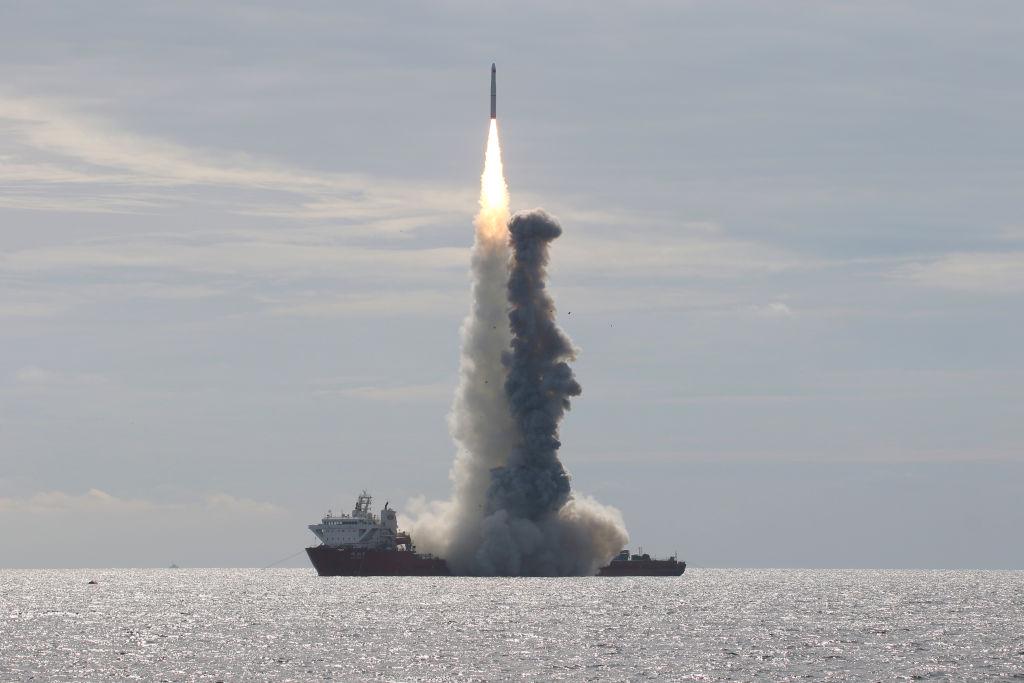China military watch
Posted By Malcolm Davis and Charlie Lyons Jones on October 2, 2020 @ 15:00

Welcome to the third edition of ‘China military watch’. This month, we take a look at China’s burgeoning missile and space capabilities.
Ballistic missiles on Chinese merchant vessels?
On 15 September, China successfully launched the Long March-11 solid propellant launch vehicle off a merchant vessel in the Yellow Sea. This was the second such sea-based launch of a rocket conducted by China, with the first taking place on 5 June last year.
The launch, overseen by the Taiyuan Satellite Launch Centre (太原卫星发射中心) in conjunction with leading ballistic missile producer the China Academy of Launch Vehicle Technology [1] (CALT, 中国航天科技), was significant as the solid propellant technology used in the in the Dongfeng-21 and Dongfeng-26 is reportedly similar [2] to that used in the Long March-11. The launching of the Long March-11 from a civilian vessel raises the prospect that China’s merchant fleet could be used to fire ballistic missiles in wartime.
While the Long March-11 is not a missile platform, reporting [3] from the People’s Liberation Army Daily on the flight test noted that launching rockets off surface vessels has several strategic advantages. The report argued that a sea-based launch ‘increas[es] launch efficiency and rocket carrying capacity’ because it can occur closer to the equator, and allows for ‘the freedom to choose launch sites, [which can] effectively offset unwanted risks’ such as debris falling on populated areas. The report added that sea-based launch provides tactical flexibility, as land-based ballistic missile and rocket systems are fixed, easily targetable and require significant logistical support.
That said, problems linger in China’s capability to conduct sea-based rocket launches. Another report [4] from the PLA Daily made clear that ‘the communications support [needed] for sea-based launch missions are extremely heavy-duty and face many challenges, including long transmission distances, highly complex equipment and tight schedules’. Overcoming these difficulties is likely to be a priority for China’s defence industrial base, as companies like CALT continue developing China’s capability to conduct sea-based launches of carrier rockets and ballistic missiles.
Towards Chinese spaceplanes
China has successfully launched [5] its own reusable military spaceplane. On 4 September, from the Jiuquan space centre in the Gobi Desert, the Chinese spaceplane was launched on a Long March-2F rocket. The Chinese spaceplane apparently follows the US X-37B [6] in its design and operation, and successfully returned [7] to earth two days after its mission began, landing at a runway next to the Jiuquan launch site, but not before it deployed [8] an unidentified object into low-earth orbit.
The spaceplane marks an important step forward for China’s space capability and particularly Beijing’s military space capability, in the same way the X-37B has enhanced the US’s ability to undertake prolonged missions in orbit for secretive purposes. There are very few details of the Chinese spaceplane available, and it seems clear that China could simply emulate the US system if it chose to do so.
Perhaps more interestingly, there’s informed speculation [9] that, unlike the US vehicle, the Chinese spaceplane may actually be the second stage of a ‘two stage to orbit’ system, with a winged, reusable and potentially crewed first stage [10] under the ‘Tengyun Project’. This vehicle would transport the spaceplane as the upper stage to a place high in the atmosphere, where it would then be launched into orbit. Such a system would be more effective in terms of rapid and responsive space launch than a rocket-based one like that employed for the X-37B, and there would be no reason why China couldn’t develop a number of such vehicles.
A CALT official suggested [8] in 2017 suggest that the system would be capable of carrying both crew and material, and in 2018, China Aerospace Science and Industry Corporation said that, ‘unlike rocket recycling adopted by SpaceX, the spaceplane can take off from an ordinary airport to transport spacecraft into orbit. It will bring about a revolution for the future aerospace transportation.’
A series of spaceplane projects [11] are underway in China. A fully reusable space capability based around a ‘two stage to orbit’ spaceplane, with perhaps a larger and more capable upper stage than that tested in September, could be a game-changer. The US considered such a capability back in the 1970s when it was first conceptualising its space shuttle and ultimately settled on a vertical launch system using an expendable fuel tank and two external boosters, along with the shuttle’s main engine, to reach orbit. It was a less elegant, more expensive and, ultimately, more dangerous approach than two stage to orbit, with the crews of the space shuttles Challenger and Columbia paying the ultimate price for that design choice.
Might China be about to exploit second-mover advantage—leapfrogging over a flawed design that characterised the US shuttle and embracing a more sophisticated, two-stage-to-orbit vehicle? Such a vehicle could transform military space competition, prompt a response from the US Space Force and intensify debate over that organisation’s rationale and future role, including the contentious issue of crewed military space missions.
Article printed from The Strategist: https://aspistrategist.ru
URL to article: /china-military-watch-3/
URLs in this post:
[1] China Academy of Launch Vehicle Technology: https://unitracker.aspistrategist.ru/universities/china-aerospace-science-and-technology-corporation/
[2] reportedly similar: https://thediplomat.com/2019/06/why-chinas-long-march-11-launch-matters/
[3] reporting: https://archive.ph/Iwdsd
[4] Another report: https://archive.ph/Htyrw
[5] launched: http://www.xinhuanet.com/tech/2020-09/04/c_1126453484.htm
[6] X-37B: /spaceplanes-high-frontier/
[7] returned: https://mp.weixin.qq.com/s?__biz=MjM5Njc4ODY1MQ==&mid=2651924705&idx=1&sn=957f00cd28f38b3a087acfc5924a3a2f&chksm=bd0668258a71e133f7e5128db96d57fd95086d8091b4112b32037e2f5012a6a2e7e63ae6d56e&xtrack=1&scene=90&subscene=93&sessionid=1599372430&clicktime=1599372643&enterid=1599372643&ascene=56&devicetype=android-29&version=27001141&nettype=internet&abtest_cookie=AAACAA%3D%3D&lang=en&exportkey=Ap2Sy2ZWSsdZDhzRfK1MSQ8%3D&pass_ticket=133GIXKGMyDW8aa5NfVa%2Bev4j2BdodlLskzqMF8ivWt6zedVzUIEFkxmQPyE5Cod&wx_header=1
[8] deployed: https://spacenews.com/chinese-reusable-experimental-spacecraft-releases-object-before-returning-to-earth/
[9] speculation: https://twitter.com/AJ_FI/status/1302491299573043200?s=20
[10] first stage: http://core.casicloud.com/zone/zoneCommercial/zoneCommercial/emphasisProject.ht?project=ty
[11] projects: https://chinaaerospace.files.wordpress.com/2020/05/chinas-space-planes4-e1588933419164.png
Click here to print.